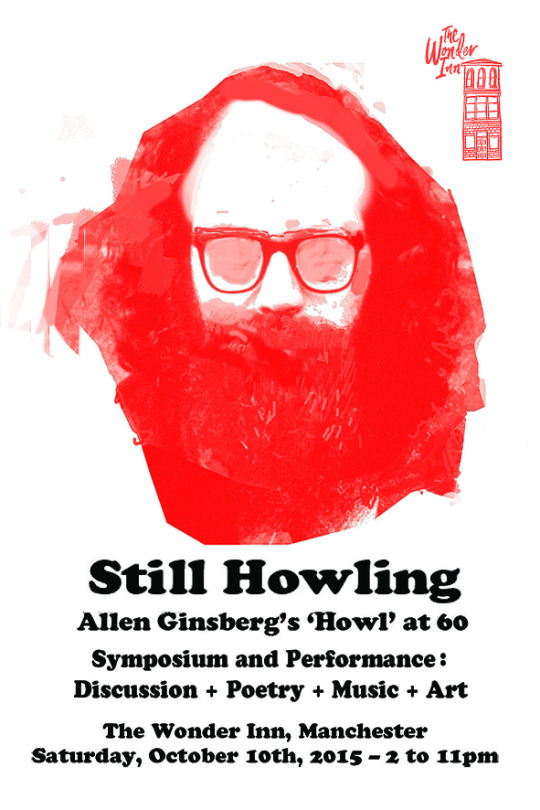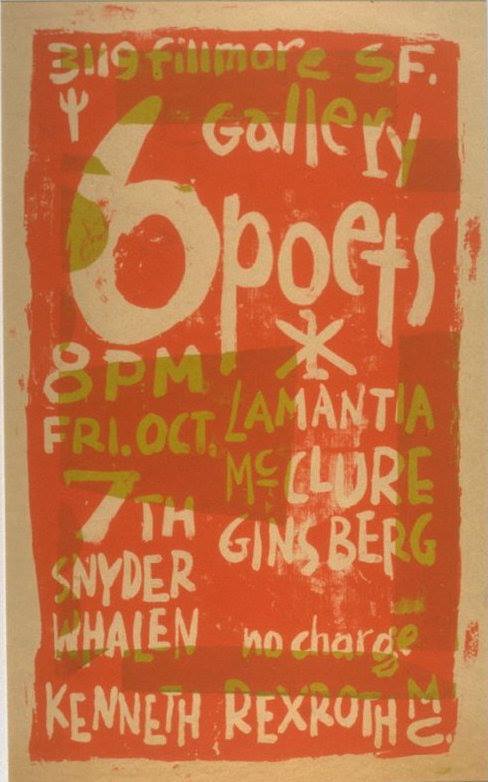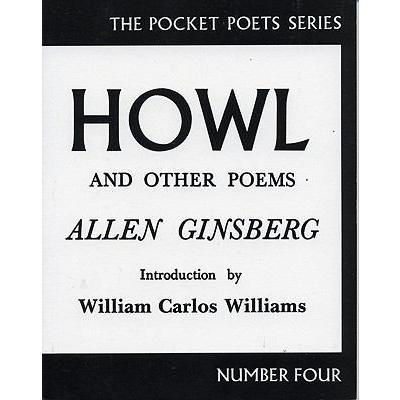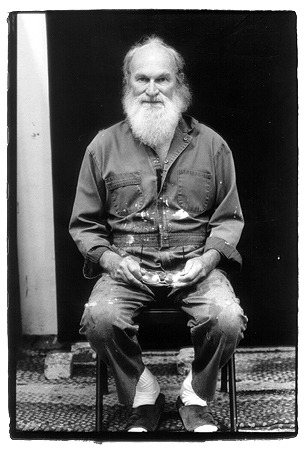
It was sixty years ago, on October 7, 1955, that Allen Ginsberg stood in the Six Gallery, a gallery/poetry space that artist Wally Hedrick had opened on Fillmore Street in San Francisco in 1954, and read his radical and epic poem “Howl” for the first time.
Hedrick had to convince his friend Ginsberg to appear. “[Hedrik] asked him to organize a poetry reading at the Six Gallery,” according to Wikipedia. “At first, Ginsberg refused. But once he’d written a rough draft of ‘Howl,’ he changed his ‘fucking mind,’ as he put it. The large and excited audience included a drunken Jack Kerouac, who refused to read his own work but cheered the other poets on, shouting ‘Yeah! Go! Go!’ during their performances.”
Ginsberg was second to last on a lineup that also included Gary Snyder, Philip Lamantia, and Philip Whalen, Michael McClure and Kenneth Rexroth.
Michael McClure later wrote: “Ginsberg read on to the end of the poem, which left us standing in wonder, or cheering and wondering, but knowing at the deepest level that a barrier had been broken, that a human voice and body had been hurled against the harsh wall of America…”
In addition to being one of the seminal works to come out of the Beat movement, “Howl” influenced numerous poets around the world, both at the time and continuing right up to today. But it also had a profound impact on many rock musicians including a young Bob Dylan, whose songwriting was clearly influenced by Ginsberg’s electric writing in that poem, which begins:
“I saw the best minds of my generation destroyed by madness, starving hysterical naked, dragging themselves through the negro streets at dawn looking for an angry fix…”
On October 10th, the 60th anniversary of that first reading of “Howl” will be celebrated during a nine hour event, Still Howling, at the Wonder Inn in Manchester, England, that will run from 2 pm until 11 pm.

Participating will be Ginsberg biographer (and Beat expert) Barry Miles, British poet Michael Horovitz who appeared along with Ginsberg at the International Poetry Incarnation at the Royal Albert Hall in 1965, Ginsberg guitarist Steven Taylor, who accompanied Ginsberg for 20 years (and a member of The Fugs for the past 30 years) and the British actor George Hunt, who will read “Howl” in its entirety. MCing will be CP Lee, author of “like the night: Bob Dylan and the road to the Manchester Free Trade Hall,” and a former senior lecturer at the University of Salford.
There will be an afternoon symposium featuring Miles, Horovitz, Taylor, Peter Hale of the Ginsberg Trust and poets Christina Fonthes and Elmi Ali, and others.
Taylor will collaborate with Horovitz, perform a solo set and give the British premiere of his short choral work, “Footnote to Howl.”
There will also be a series of musical performances, paying reference to Ginsberg and the Beats, by spoken word artist Heath Common, joined by the Lincoln 72s and Dub Sex front man Mark Hoyle, alt-folk singer-songwriter Chris T-T, whose debut album was called Beatverse, and the Isness.
The event is co-produced by Beat authority Simon Warner, who in 2005 organized a 50th anniversary celebration of the first reading of “Howl,” and Manchester-based installation artist Roger Bygott. “Roger proposed we try and do another [‘Howl’] birthday event,” Warner explained via email from Leeds, England, where he teaches at the University of Leeds. “A decade on seemed a good moment to return to this seminal moment in twentieth-century poetry.”

Warner has been a fan of ‘Howl’ since he first read it as a teenager. “At first Ginsberg’s poem seems like a dislocated explosion, a chaotic stream of consciousness,” Warner said during a 2013 interview. “But when you start to unpack the details and debate the reasons why the poet uses such a fragmented form, its treasures are many. Its language is rich and raucous, surprising, sometimes shocking. ‘Howl’ is one of the great modernist statements, to rank with masterpieces by Picasso and Brecht, Beckett and Eliot. Its truths lie in its dissonance, in its fragmented shards, in its huge rolling passion, its heartfelt gravity.”
It was in the late ‘70s that Warner discovered the Beats. “I first encountered the names of the Beats through publications like New Musical Express, a weekly magazine forging an alternative voice and confirming that there were links between popular musical expression and the ideas of those maverick American writers,” he wrote in his email. “But then I read Ann Charters’ biography of Kerouac, the first such book to profile the novelist, then came across a remarkable late 1950s compilation called ‘Protest,’ which gathered work by the Beats and the UK’s Angry Young Men, and ‘Howl’ was one of the featured items.”
While Kerouac’s “On the Road” is likely the most popular (and influential) piece of writing to emerge from the Beat scene, Warner thinks “Howl” – published a year before “On the Road” – is just as important a literary work, perhaps more important.
“I think that ‘Howl’ was a genuine game-changer in all sorts of ways,” Warner wrote. “Until then, this underground gathering of friends and lovers, largely unpublished novelists and poets, dubbed the Beat Generation, was essentially beneath the radar, largely anonymous. Ginsberg was desperate to escape the formal strictures of the academy when it came to poetry, but he was very nervous about expressing his most intense, inner personal feelings.
“Here was a Jewish, socialist, second-generation Russian immigrant and a homosexual man to boot, who was likely to upset the conservative WASP establishment on so many levels, at a time when anyone stepping out of line faced censure, the prospect of unemployment, even imprisonment,” Warner continued. “Ginsberg had devised a new observational poetry, a fractured, fractious consideration of contemporary America, a modernist view of a land ensnared in the post-war paranoia of Cold War politics.
“Yet there was also a deep humanity to the piece,” Warner wrote. “The poem was certainly a tremendously brave gesture and once it was read in the Six Gallery on October 7th, 1955, the padlocks of repression and inhibition were smashed. In short, ‘Howl’ introduced powerful and controversial ideas but also trumpeted, by name, those very writers who would become the key, published members of the Beat community, widely read and acclaimed in the decade that followed. It also opened up the possibility of the counterculture having a voice and, it might be argued, was actually a significant preface to what happened, socially, culturally, even politically, in the West in the 1960s.”
Warner is the author of “Text and Drugs and Rock ‘n’ Roll: The Beats and Rock Culture,” and in that book he makes the case that the Beats, including Ginsberg, had an immense influence on rock music.
“The Beats had a tremendous impact on rock culture,” Warner wrote in the email. “Particularly that version of sophisticated rock music that emerged around 1965 and 1966, that time when Dylan went electric, when the Beatles entered a new era of musical and lyrical maturity.
“Artists from the Doors to Jefferson Airplane, the Stones to Pink Floyd, the Grateful Dead to Van Morrison and Cream, acknowledged the influence that writers like Kerouac, Burroughs and Ginsberg had had on their sensibilities, opening their consciousness and encouraging them to be more adventurous artistically.”

For more info on Still Howling, head to the Facebook page.
– A Days of the Crazy-Wild blog post –